MARK BANDO'S WEBSITE
Marshalling Area
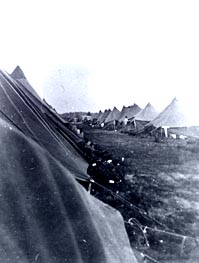
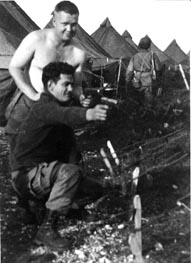 In preparation for a combat jump, paratroopers were moved into tent cities as shown above, near departure airfields. These
"Marshalling Areas" were sealed-off with barbed wire fences and armed guards for several days prior to the jump. This was intended to prevent security leaks as to the destination where the troopers would land. During this time, nobody could leave nor enter the area. In the photo at right, "Red" a 502 Sv co. man assigned to Graves Registration duties, and a 2/502 medic named Francis Palm, experiment with Government Model.45 pistols. Palm was captured near Best, Holland with James Milne and others, and spent the duration as a P.O.W. GRS men were allowed to carry weapons, but Medics were supposed to be unarmed. Some individual medics carried a weapon, regardless
of the rules. German medics carried a pistol in order to administer the 'Coup de Grace' to hopelessly injured battlefield casualties. photos courtesy Jim Marshall G/501 and Ernie Labadie 2/502
In preparation for a combat jump, paratroopers were moved into tent cities as shown above, near departure airfields. These
"Marshalling Areas" were sealed-off with barbed wire fences and armed guards for several days prior to the jump. This was intended to prevent security leaks as to the destination where the troopers would land. During this time, nobody could leave nor enter the area. In the photo at right, "Red" a 502 Sv co. man assigned to Graves Registration duties, and a 2/502 medic named Francis Palm, experiment with Government Model.45 pistols. Palm was captured near Best, Holland with James Milne and others, and spent the duration as a P.O.W. GRS men were allowed to carry weapons, but Medics were supposed to be unarmed. Some individual medics carried a weapon, regardless
of the rules. German medics carried a pistol in order to administer the 'Coup de Grace' to hopelessly injured battlefield casualties. photos courtesy Jim Marshall G/501 and Ernie Labadie 2/502
Missed Opportunity
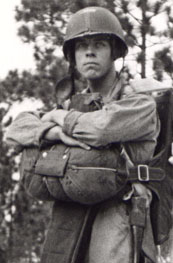 On 7 June, 1944, four rounds from the 8 inch guns of the cruiser USS Quincy II dropped short on 2/501 near la Haute Addeville, killing and wounding about ten American paratroopers by accident.
Glen A. Derber of Oshkosh, WI (pictured above), received a shell splinter in the right shoulder. Refusing to be evacuated, Glen continued firing his '03 Springfield rifle, the butt of which kept kicking his wound, until the shrapnel eventually worked itself out. On June 8th, Glen spotted a German several hundred yards away, standing in open view. This Kraut was not aware that he was under observation. Although assigned to the machinegun platoon of 2/501, Glen was a crack rifle shot and had competed in N.R.A. tournaments back in the states. He began making careful adjustments to the sights of his '03, to compensate for the long distance shot. Sgt Harry Amos, an Old Army regular happened along and asked Glen what he was doing. "I'm adjusting my sights, so I can take a shot at that kraut over there", said Glen. "Hell! You don't have time to adjust your sights in combat!" said Amos. He unslung his carbine and fired five wild shots in the general direction of the Kraut, scaring him off.
Glen later wrote: "This irked me, as I felt I could have gotten that Kraut with a careful shot." Using his '03 in October, 1944, on the dike near Heteren, Holland, Glen did take out some Germans who were nearly 400 yards distant.
Facing toward Arnhem along the main dike east of Heteren, the dike curved
in such a way that Glen could see Germans on the opposite side of the same dike hundreds of yards east of his position. Sgt Amos was killed in action later in WW2. photo courtesy Glen A. Derber
On 7 June, 1944, four rounds from the 8 inch guns of the cruiser USS Quincy II dropped short on 2/501 near la Haute Addeville, killing and wounding about ten American paratroopers by accident.
Glen A. Derber of Oshkosh, WI (pictured above), received a shell splinter in the right shoulder. Refusing to be evacuated, Glen continued firing his '03 Springfield rifle, the butt of which kept kicking his wound, until the shrapnel eventually worked itself out. On June 8th, Glen spotted a German several hundred yards away, standing in open view. This Kraut was not aware that he was under observation. Although assigned to the machinegun platoon of 2/501, Glen was a crack rifle shot and had competed in N.R.A. tournaments back in the states. He began making careful adjustments to the sights of his '03, to compensate for the long distance shot. Sgt Harry Amos, an Old Army regular happened along and asked Glen what he was doing. "I'm adjusting my sights, so I can take a shot at that kraut over there", said Glen. "Hell! You don't have time to adjust your sights in combat!" said Amos. He unslung his carbine and fired five wild shots in the general direction of the Kraut, scaring him off.
Glen later wrote: "This irked me, as I felt I could have gotten that Kraut with a careful shot." Using his '03 in October, 1944, on the dike near Heteren, Holland, Glen did take out some Germans who were nearly 400 yards distant.
Facing toward Arnhem along the main dike east of Heteren, the dike curved
in such a way that Glen could see Germans on the opposite side of the same dike hundreds of yards east of his position. Sgt Amos was killed in action later in WW2. photo courtesy Glen A. Derber
Controversial Photo
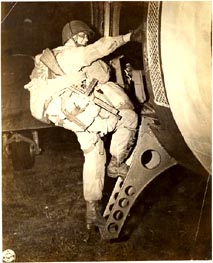 This famous photo appeared on the cover of YANK Magazine the 2 July, 1944 issue, also on the cover of George Koskimaki's book 'D-Day With the Screaming Eagles'. Like the photo of Ike with Lt Strobel, this has led to many claims by people that they-or someone in their company, are the man in the picture. Even members of the 82nd Airborne Division have claimed the man shown climbing into the plane as one of their own. Their claim is supported by the absence of a helmet stencil on the trooper shown, although 3/506th wore small stencils, and the angle from which the photo was made might have rendered an existing stencil impossible to see in the photo. Informed vet sources say that the trooper is T/4 Joseph F. Gorenc, ASN:16131251, of HQ/3, 506th PIR. Before D-Day, Joe worked in 3rd Bn S-3, doing training related functions like map making and constructing sand tables of the Drop Zone in cooperation with S-2.
This famous photo appeared on the cover of YANK Magazine the 2 July, 1944 issue, also on the cover of George Koskimaki's book 'D-Day With the Screaming Eagles'. Like the photo of Ike with Lt Strobel, this has led to many claims by people that they-or someone in their company, are the man in the picture. Even members of the 82nd Airborne Division have claimed the man shown climbing into the plane as one of their own. Their claim is supported by the absence of a helmet stencil on the trooper shown, although 3/506th wore small stencils, and the angle from which the photo was made might have rendered an existing stencil impossible to see in the photo. Informed vet sources say that the trooper is T/4 Joseph F. Gorenc, ASN:16131251, of HQ/3, 506th PIR. Before D-Day, Joe worked in 3rd Bn S-3, doing training related functions like map making and constructing sand tables of the Drop Zone in cooperation with S-2.
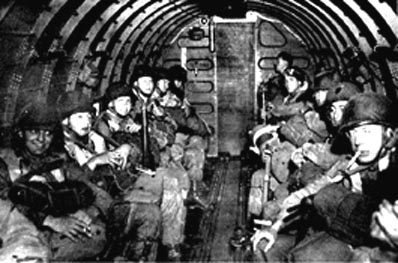 The Signal Corps took that photo and also another one, shown above, after the jumpers were seated in the plane. This was the plane on which LTC Robert Wolverton flew to Normandy. In this
photo, Gorenc is seated at far left, with a cigarette in his right hand. Ray Calandrella (pictured at right, with goggles on helmet-back near the bulkhead), saw Gorenc as a prisoner of war at St Come du Mont, France on the evening of 6 June, 1944. But Gorenc must have escaped, as he appears on the Market-Garden roster for 3/506 in September, 1944. Ray went to Sheboygan, WI after WW2, to look for Joe Gorenc. Instead, he found Joe's widow Bernice. He learned that Joe had been killed in an industrial accident in the 1950's. An oxydizer exploded, spraying Joe with hot oil, and he died several days later in a hospital.
The Signal Corps took that photo and also another one, shown above, after the jumpers were seated in the plane. This was the plane on which LTC Robert Wolverton flew to Normandy. In this
photo, Gorenc is seated at far left, with a cigarette in his right hand. Ray Calandrella (pictured at right, with goggles on helmet-back near the bulkhead), saw Gorenc as a prisoner of war at St Come du Mont, France on the evening of 6 June, 1944. But Gorenc must have escaped, as he appears on the Market-Garden roster for 3/506 in September, 1944. Ray went to Sheboygan, WI after WW2, to look for Joe Gorenc. Instead, he found Joe's widow Bernice. He learned that Joe had been killed in an industrial accident in the 1950's. An oxydizer exploded, spraying Joe with hot oil, and he died several days later in a hospital.
BTW, Ray Olson of HQ/3 502, says the man boarding the plane is S/Sgt Davis Vaughn, of H/502. Mario Patruno of F/506th says it is Bill Green of his company.
Now, in deference to the 82nd Airborne's claim, I received the following email letter in September of 2004:
Dear Mark,
I love your web site. I am writing regarding the Controversial photo you have posted, the one of a single trooper entering the C-47 the morning of D-day. I know that many people clam this photo and it is one that I am very proud of. The true identity of this photo is my uncle 2d lt Robert M. Matteson
1/505 company A ( he was a sergent at the time of the photo). I grew up with this picture on my wall and in my family photo album. This picture is not the typical snap shot taken on the spur of the moment. The is a staged
picture taken by the signal corps. There was a man standing directly behind my uncle watching this photo taken and this is the man that has identified the content of this photo to my uncles 5 sisters in 1944. The man standing behind this photo was private Pigue 1/505.
For years this was just a photo of Uncle Bob, then I started to do research on the internet about him and to my amazement I found this photo everywhere. I am not sure if you will change the title of this photo but I do have 4 of his sisters still alive that can verify this and I have one
brother that looks like a clone of this photo.
Stuart Spears.
The debate goes on.
The Road to Bourcy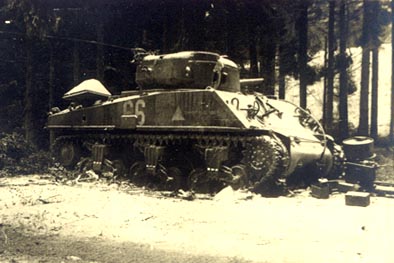 This M-4 A-3 Sherman tank of the 6th Armored Division was knocked out by a German 75mm anti tank gun
on 3 January, 1945. The tank was pushing along a road parallel to the railroad line NE of Bastogne, toward the hamlet of Bourcy, Belgium. Bourcy would not be taken until 14 January.
This M-4 A-3 Sherman tank of the 6th Armored Division was knocked out by a German 75mm anti tank gun
on 3 January, 1945. The tank was pushing along a road parallel to the railroad line NE of Bastogne, toward the hamlet of Bourcy, Belgium. Bourcy would not be taken until 14 January.
The 'Super Sixth' was withdrawn in the middle of this attack to move to another sector, leaving elements of the 501, which they had been supporting, with their right flank exposed.
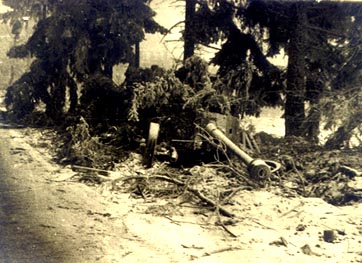 The PAK 75mm anti tank gun which KO'd the U.S. tank shown above was partially hidden under the trees. Captain Joe Pangerl of 502 IPW came upon the scene over a week later and snapped these photos.
The PAK 75mm anti tank gun which KO'd the U.S. tank shown above was partially hidden under the trees. Captain Joe Pangerl of 502 IPW came upon the scene over a week later and snapped these photos.
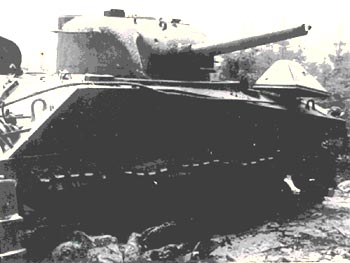 A view of the opposite side of the tank shows a German soldier lying at the base of the KO'd Sherman, with much of the flesh blown away from his legs. Joe
surmised in retrospect that the German was a member of the PAK crew, who ventured out to examine his handiwork, and somehow got killed for his curiosity.
photos courtesy Joe Pangerl.
A view of the opposite side of the tank shows a German soldier lying at the base of the KO'd Sherman, with much of the flesh blown away from his legs. Joe
surmised in retrospect that the German was a member of the PAK crew, who ventured out to examine his handiwork, and somehow got killed for his curiosity.
photos courtesy Joe Pangerl.
Jisy O'Narien-French Para Belle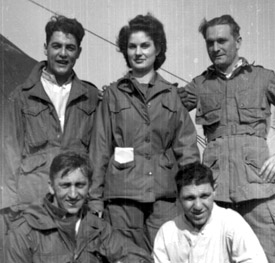 A 21 year old employee at the Division I.G. office in September, 1945, was voted the best looking parachutist in the 101st. When she was 18 in 1942, Mademoiselle Jisy O'Narien saw her mother taken away by the Germans for helping the French Underground. Jisy then decided to go to England to join her uncle, a major in a French parachute battalion. Smuggled across the border into Spain by French loyalists, she made her way to Gibraltar and thence by boat to England.
A 21 year old employee at the Division I.G. office in September, 1945, was voted the best looking parachutist in the 101st. When she was 18 in 1942, Mademoiselle Jisy O'Narien saw her mother taken away by the Germans for helping the French Underground. Jisy then decided to go to England to join her uncle, a major in a French parachute battalion. Smuggled across the border into Spain by French loyalists, she made her way to Gibraltar and thence by boat to England.
She located her uncle and learned that women were being trained as parachutists. Against her uncle's objections, she volunteered and got her wings in spring, 1943. In June, 1943, Jisy and five male operatives parachuted into Grenoble, France and worked with the Maquis in identifying targets for RAF bomb raids. She joined with the Maquis in guerilla raids on the occupying Nazi forces. Once, she narrowly escaped death when captured with a male operative driving a vegetable cart loaded with air-dropped ammunition. Her partner was able to kill their German captors, although the truckload of ammunition was lost as the duo escaped.
In August, 1944, Jisy was captured and tortured by the Gestapo in Auxerre, France. She refused to divulge any information about Maquis operatives sought by the Nazis. Scheduled for execution, she was rescued at the 11th hour by a Maquis raid.
In 1945, Jisy offered her services to the 101st Airborne Division. In a photo made by John Gabor in September, 1945, Jisy is seen with members of HQ/2 506th. John Gabor is at bottom left.













